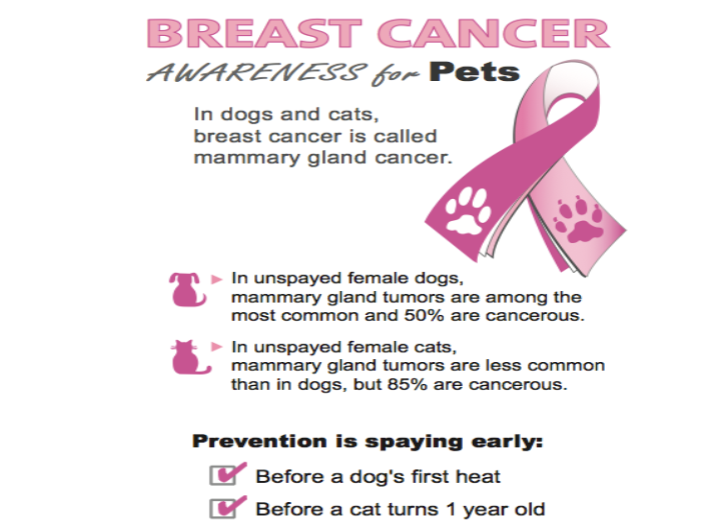
Visit us in October
1. Our technicians will teach you to check your pet for breast cancer.
2. For the following 6 months, if you suspect breast cancer in your pet, we will do a free breast exam on your pet if you visited us in October 2025
Veterinarian campaigns for awareness of mammary gland cancer
Dr. Marthina Greer finds it heartbreaking to see a dog die from a disease that could have been prevented. She wants pet owners to know that mammary gland cancer — the veterinary equivalent of breast cancer, can often be avoided by spaying at a young age.
Dr. Greer, who specializes in canine reproduction, works with many breeders who keep their dogs intact. She rarely loses a breeding dog to mammary cancer because breeders tend to watch closely for changes and remove any suspicious masses right away. It’s the average pet owner, she says, who often isn’t aware of the link between breast cancer in female dogs and spaying.
“Shelters and others have done a great job of teaching people about spaying as population control,” Greer said.
“But breast cancer prevention has not been emphasized as a reason to spay your dog.”
At her Lomira, Wis., practice, Greer diagnoses around one new case of canine breast cancer every week. “The ones we lose are usually pets who were never spayed, never bred, and never intended to be bred,” she explained. In her 30 years of practice, she has seen four cases of inflammatory mammary carcinoma — what she calls “the worst of the worst” because of its aggressive nature.
Part of the problem, she believes, is language. “We call it ‘mammary tumors,’ and many clients don’t understand what that means. If we used the term ‘breast cancer,’ it would be much clearer.”
Breast Cancer in Pets
The exact cause of mammary cancer is unknown, though hormones are believed to play a role. Signs may include firm nodules around the nipples, ulcerated skin, swelling, inflammation, or discharge. Cats are also at risk. While mammary cancer is less common in cats than dogs, it is usually much more serious.
Studies show that 80–90% of feline mammary tumors are malignant, compared to about 50% in dogs. “Mammary gland cancer is certainly among the top three most common cancers in cats,” said Dr. Ruthann Chun, a board-certified oncologist at the University of Wisconsin School of Veterinary Medicine. “We see more dogs with mammary cancer overall, but when it occurs in cats, it is far more likely to be malignant.”
Dr. Corey Saba, an oncologist at the University of Georgia College of Veterinary Medicine, agrees that timing of spay is the strongest predictor. “Because most pets in the U.S. are spayed as kittens and puppies, we don’t see as much mammary cancer here. In other parts of the world, where spaying is less common, the disease is diagnosed more frequently.”
Saba recommends spaying cats between 6 months and 1 year of age, since cats spayed after their first year are at higher risk.
The Timing Matters
Research shows that spaying before the first heat cycle offers the greatest protection. Spaying before age 2 prevents nearly all cases of mammary cancer in dogs.
Greer emphasizes, however, that spaying does have drawbacks. Dogs spayed young may face increased risks of certain other conditions, including bone cancer and hypothyroidism. “That’s why spaying should be discussed with each client,” she said. “Owners need to understand all the risks and benefits. But one thing is clear: spaying under age 2 prevents most breast cancers in dogs.”
What Pet Owners Can Do
Just as women are encouraged to perform monthly breast self-exams, Greer wants pet owners to check their female pets. She suggests doing the exam on the same day you check yourself and is considering reminder stickers similar to those used for flea and tick prevention. “Since dogs can’t do self-exams, we have to do them for them,” she explained. Any firm lump should be checked by a veterinarian right away.
Awareness Campaign
To spread the word, Greer hopes to launch a national campaign in the future. For now, her clinics are offering a free breast exam for pets if you visited in October 2025, valid for six months afterward if you ever suspect a lump. She also plans to create an educational video featuring a human breast cancer survivor alongside a dog that successfully overcame breast cancer.
Her message is simple but powerful:
Spaying is not just about population control. It’s about saving lives.

Event Date
Oct 01 '25 12:00 AM - Oct 31 '25 11:59 PM
Address
N11591 Columbia Dr.
Lomira, WI 53048
United States
